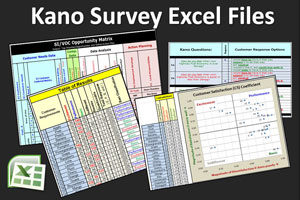Can using the Kano Model lead to retaining satisfied customers?
Yes and No, the Kano Model itself does nothing other than help you understand and classify the 3 uniquely different types of needs. (Basic, Performance, and the hardest but most rewarding, Excitement). Capturing, understanding, and successfully delivering on these types of Needs will help you retain satisfied customers. Several “post Kano” techniques can be used to further prioritize and manage the needs throughout your product development process. Many of these techniques are introduced in the Kano Video on our home page. Watch it again if you missed them. There are also surveys you can run to help categorize the needs.
You only show 3 Kano classifications, I have heard there are actually 5?
Yes, there are five but the other 2 represent rare situations. The 4th is called “Indifferent”. Here is where the customers are neutral whether they don’t get them or do get them. Whether they are not fulfilled or completely fulfilled. The 5th is called “Reverse” and it is when you don’t fulfill them the customer is very satisfied and when you do fulfill them the customer is very dissatisfied. There are several reasons this can happen, one of the common ones is the customer misinterpreted the need in the survey you designed.
Since the Model was conceived in the 80’s is it relevant today?
Gravity was “discovered” thousands of years ago and is still relevant today. I’m being a little sarcastic here, but my point is simple: The model was relevant in the 80’s and is VERY relevant today and will be down the road as long as there are Customers to satisfy. Any time anyone is developing a Product, Service, Software Application, or Business Process that has customers to satisfy, it is relevant because all Customers have “Basic and Performance” needs and when there are many choices, “Excitement Needs” often are great “tie-breakers”.
I have heard the 3 main Kano classifications called something different?
We have also seen them called many names. Kano originally called the 3 types of needs (Must Be’s, One Dimensional, and Attractive for what we call Basic, Performance, and Excitement) Some feel the new names are easier to understand, some use his original names, and some have created their own names. What you call them is up to you as long as you are consistent with the meaning behind each of them.
What is a Kano Survey (or Kano Analysis)?
Here is the short answer: A Kano Analysis (or Survey) is a survey designed to determine which classification a need falls under to help prioritize the needs. (A 40 minute tutorial is available on the Products and Services page) The steps in the process include:
- Identify Customers
- Determine the Customer Requirements
- Develop a (functional and non-functional) Questionnaire for each of the needs/attributes
- Test and Administer the Questionnaire
- Tabulate and Analyze the Results
- Decide how to Act on the Results
Will a Kano Survey do everything I need for a VOC Project?
Remember, the Kano Model (And Kano Survey), is a subset of a good Voice of Customer/Client effort. The Kano Survey by itself will not accomplish most project goals. VOC Project goals are typically much bigger than just a Kano Survey. (The Kano survey by itself classifies Needs or Features into 5 categories – B, P, E, I, R) Typical VOC project goals are to A) Understand who the Customers/Client are, B) Understand What their Needs are, C) Prioritize their Needs, D) Set performance goals/targets for each of the needs, and D) Begin to develop solutions for each of the Customer/Client needs. An typical “Kano Survey” will only do part of that so needs to involve additional VOC activities. A typical Kano Survey has the following elements:
- A list of “paired” questions to determine the Kano classification (B, P, E, I, or R)
- A separate list of questions to determine importance’s of Needs knowing not all needs are of equal importance. We recommend a technique called AHP (Analytic Hierarchy Process) to determine relative importances. It is a very effective effort that compares 2 Needs at a time to ultimately calculate Importances.
- EXAMPLE Q1: “What is more important, Shelf Life or Accuracy of Inventory?”
- EXAMPLE Q2: How much more important is the one over the other”?
- The survey provides responses to choose from and goes on to automatically calculate and normalize relative importances.
- A separate list of questions to determine current satisfaction of the Needs is also recommended (if appropriate) Here we simply ask their satisfaction of the needs on a “polar scale”
EXAMPLE Q3: “On a poor to excellent scale, how accurate is your current inventory?”
Before the Kano Survey is even thought about, there are several qualitative questions that should be asked to get the list of needs for the Kano Survey. In our Kano Workshops we go over at least 2 dozen open ended questions to get at Customer Needs for the quantitative research which will follow. The survey results will then be analyzed for priorities and an action plan will be developed which includes determining/brainstorming the conceptual solution to the need, lead responsibility, detailed design of the solution, etc.
Is the Kano Model useful in a Non-Profit or B2B Environment?
YES, The Kano Model is useful in ANY environment where you have customers you need to satisfy. The main point of the Kano Model is to 1) Understand that your Customers have 3 uniquely different types of Needs (Basic, Performance, and Excitement), then 2) Prioritize them to make sure you are spending your energy on the ones that have the biggest impact on customer satisfaction and sales for the product or service you are developing or improving. It is that simple and difficult. There are many “VOC” (Voice of the Customer) tools available to make the journey much easier. Tools that help in identifying the needs, prioritizing the needs, developing ideas and concepts around the needs, solving problems along the way.
Who is the Customer in a B2B Environment?
Not only is your immediate Customer (The Business) but more often than not, you should consider your “Customers” Customer – and maybe even your “Customers’ Customers’ Customer”. How confident are you that your immediate “B2B” Customer has completely understood their Customers Needs? Teams often create a Value Chain of customers and consider how each of the “Value Chain Customers” needs may be able to be addresses in the product or service they are designing. There are many good questions you can ask your “BUSINESS CUSTOMER” to clarify their needs and different questions you should be asking your Customers Customer (End Consumer) to get at their needs
How do you get at Kano’s “Excitement Needs”?
There are numerous high quality techniques that can help not only uncover Latent Customer Needs but also come up with new features for your offering that will “WOW” the Customer. For some of the tools you need Customer Input (like Painstorming, Ethnography, and Trend Analysis) to discover Excitement Quality, but there are also many uniquely effective techniques to deliver Excitement Quality that do not need any Customer input (Tools like Patterns of Evolution, the Holistic Cube, The MSE Effect, the 40 Inventive Principles just to name a few) Check out the videos for more detail on a Systematic Innovation Process on the FREE Tutorials Page of this website. Also check out our brand new (Launched in 2017) “sister site” devoted to Kano’s Excitement Quality and Systematic Innovation. www.InnovationTutorials.com (Inventive Thinking Skills)
Also check out our brand new (Launched in 2017) “sister site” devoted to Kano’s Excitement Quality and Systematic Innovation. www.InnovationTutorials.com (Inventive Thinking Skills)




